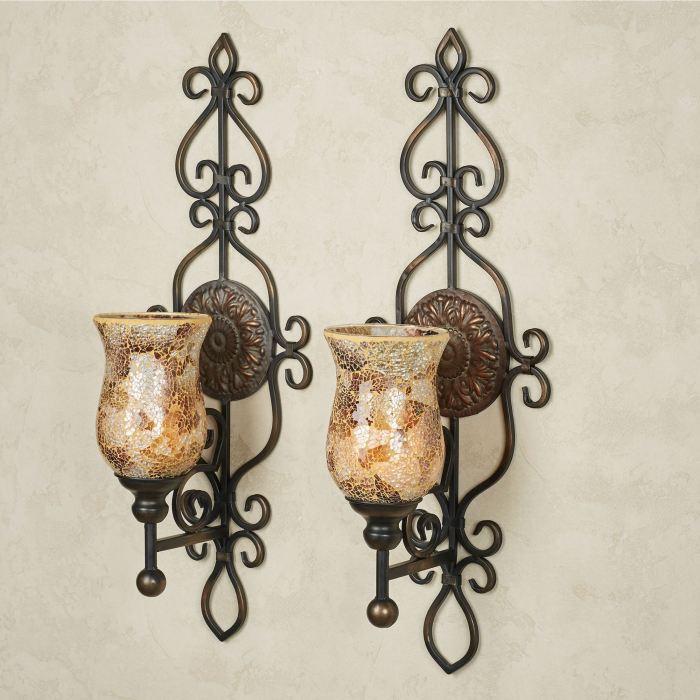Decorative wall sconces transform a space, adding both functional lighting and artistic flair. From the sleek minimalism of modern designs to the warm rustic charm of traditional styles, sconces offer a versatile way to enhance any interior. This guide explores the diverse world of decorative wall sconces, covering styles, placement, installation, and maintenance, empowering you to make informed choices that perfectly complement your home’s aesthetic.
We’ll delve into the various materials used—metal, glass, wood, ceramic—and how these contribute to the overall look and feel. We’ll also discuss the impact of lighting style (ambient, task, accent) on sconce selection and placement, providing design tips for seamless integration into diverse interior design schemes, from farmhouse chic to mid-century modern. Learn how to choose the right bulb type, troubleshoot common issues, and extend the life of your sconces.
Functionality and Lighting: Decorative Wall Sconces

Decorative wall sconces offer more than just aesthetic appeal; they provide functional illumination, enhancing the ambiance and practicality of a space. The choice of light bulb and the sconce’s features significantly impact its overall performance and effectiveness. Understanding these factors is crucial for selecting the right sconce to meet your specific needs.Choosing the appropriate light bulb type is paramount for achieving the desired lighting effect and energy efficiency.
Light Bulb Compatibility
Wall sconces accommodate various light bulb types, each with its own set of advantages and disadvantages. Incandescent bulbs offer warm, inviting light but are less energy-efficient and have shorter lifespans compared to other options. Halogen bulbs provide brighter light and are more energy-efficient than incandescent bulbs, but they generate more heat and are also less energy-efficient than LEDs.
LED (Light Emitting Diode) bulbs are the most energy-efficient option, boasting long lifespans and a wide range of color temperatures, from warm white to cool white. The choice depends on the desired ambiance and energy consumption priorities. For instance, a bedroom might benefit from warm-white incandescent or LED bulbs for a relaxing atmosphere, while a kitchen or bathroom might prefer the brighter, cooler light of halogen or cool-white LED bulbs.
Dimmable Sconces: Benefits and Drawbacks, Decorative Wall Sconces
Dimmable sconces offer the flexibility to adjust the light intensity to suit different moods and activities. This feature enhances versatility and control over the lighting environment. The benefits include creating a relaxing atmosphere in the evening by lowering the light intensity, conserving energy by using less light when needed, and extending the lifespan of the bulbs by reducing the strain on them.
However, dimmable sconces require compatible dimmers and bulbs. Using an incompatible dimmer switch can damage the bulbs or the dimmer itself. Furthermore, the initial cost of dimmable sconces and compatible dimmers may be slightly higher than non-dimmable options.
Installing Different Types of Wall Sconces
Proper installation ensures both safety and optimal functionality. The installation process varies depending on the sconce’s wiring type.
- Hardwired Sconces: Hardwired sconces require direct connection to the home’s electrical wiring. This usually involves turning off the power at the breaker box, carefully removing the existing wall plate, connecting the sconce’s wires to the house wiring according to the wiring diagram provided with the sconce (typically black to black, white to white, and ground to ground), securing the sconce to the junction box, and replacing the wall plate.
This process necessitates some basic electrical knowledge and should be undertaken by a qualified electrician if you are unsure. Failure to correctly wire a hardwired sconce can lead to electrical hazards.
- Plug-in Sconces: Plug-in sconces offer a simpler installation process, requiring no electrical wiring expertise. These sconces have a plug that connects directly to a nearby wall outlet. Simply plug the sconce into the outlet and position it on the wall according to your preference. This type of sconce is ideal for renters or those who want to avoid complex electrical work.
However, the placement is limited by the availability of a nearby outlet.
Ultimately, selecting the perfect decorative wall sconces involves considering both functionality and aesthetics. By understanding the different styles, materials, and placement strategies, you can elevate your home’s ambiance and create a space that reflects your personal style. Remember to consider the overall design scheme, lighting needs, and maintenance requirements to ensure your sconces not only look stunning but also serve their purpose effectively for years to come.
Let your sconces illuminate your home with style and grace.